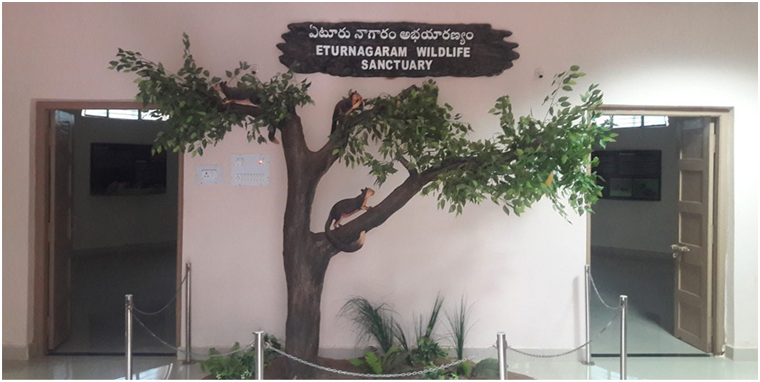
Eturnagaram Wildlife Sanctuary
Eturnagaram Wildlife Sanctuary
- A rarest of rare weather phenomenon- the collision of two cyclones- has been found to have caused flattening of thousands of trees in the Eturnagaram wildlife sanctuary in Mulugu district.

About Eturnagaram Wildlife Sanctuary:
- Location:
- Eturnagaram Wildlife Sanctuary is located near the border of Maharashtra, Chhattisgarh and Telangana in the village of Eturnagaram, a tribal village in Mulugu district of Telangana.
- It is located 100 km from Warangal and 250 km from Hyderabad.
- It was declared as a wildlife sanctuary in 1952 by Hyderabad Nizam Government.
- It is spread over an area of around 806 sq. km.
- River:
- It has a water source called Dayyam Vagu, which separates the sanctuary into two parts.
- River Godavari also passes through it.
- Flora:
- The region is covered completely with thick natural vegetation and it falls in the tropical dry deciduous.
- It is rich in the growth of teak, bamboo and other trees like madhuca and terminalia.
- Fauna:
- This sanctuary provides shelter to Tiger, Leopard, Panther, Wolf, Wild Dogs, Jackals, Sloth Bear, Chousingha, Black Buck, Nilgai, Sambar, Spotted Deer and Four Horned Antilope etc.
- The plethora of water in the sanctuary is attributed to the presence of reptiles like the famous Mugger crocodiles and snakes like the Cobra, Python and Krait.
- The famous Sammakka-Saralamma Temple is situated inside the sanctuary.
एटुरनगरम वन्यजीव अभयारण्य
- एक अत्यंत दुर्लभ मौसमी घटना – दो चक्रवातों की टक्कर – के कारण मुलुगु जिले के एतुरनगरम वन्यजीव अभयारण्य में हजारों पेड़ गिर गए।
एतुरनगरम वन्यजीव अभयारण्य के बारे में:
- स्थान:
- एतुरनगरम वन्यजीव अभयारण्य महाराष्ट्र, छत्तीसगढ़ और तेलंगाना की सीमा के पास तेलंगाना के मुलुगु जिले के आदिवासी गांव एतुरनगरम में स्थित है।
- यह वारंगल से 100 किमी और हैदराबाद से 250 किमी दूर स्थित है।
- इसे 1952 में हैदराबाद निजाम सरकार द्वारा वन्यजीव अभयारण्य घोषित किया गया था।
- यह लगभग 806 वर्ग किमी के क्षेत्र में फैला हुआ है।
- नदी:
- इसमें दयाम वागु नामक एक जल स्रोत है, जो अभयारण्य को दो भागों में विभाजित करता है।
- गोदावरी नदी भी इसके बीच से होकर गुजरती है।
- वनस्पति:
- यह क्षेत्र पूरी तरह से घने प्राकृतिक वनस्पतियों से आच्छादित है और यह उष्णकटिबंधीय शुष्क पर्णपाती में आता है।
- यह सागौन, बांस और मधुका और टर्मिनलिया जैसे अन्य पेड़ों की वृद्धि में समृद्ध है।
- जीव-जंतु:
- यह अभयारण्य बाघ, तेंदुआ, तेंदुआ, भेड़िया, जंगली कुत्ते, सियार, भालू, चौसिंघा, काला हिरण, नीलगाय, सांभर, चित्तीदार हिरण और चार सींग वाले मृग आदि को आश्रय प्रदान करता है।
- अभयारण्य में पानी की अधिकता का श्रेय प्रसिद्ध मगर मगरमच्छ जैसे सरीसृपों और कोबरा, अजगर और क्रेट जैसे सांपों की मौजूदगी को दिया जाता है।
- प्रसिद्ध सम्मक्का-सरलम्मा मंदिर अभयारण्य के अंदर स्थित है।